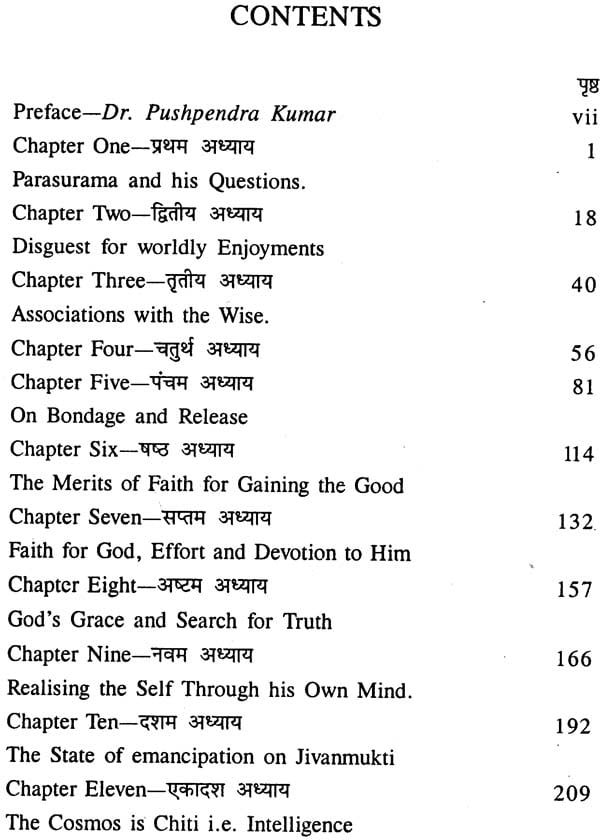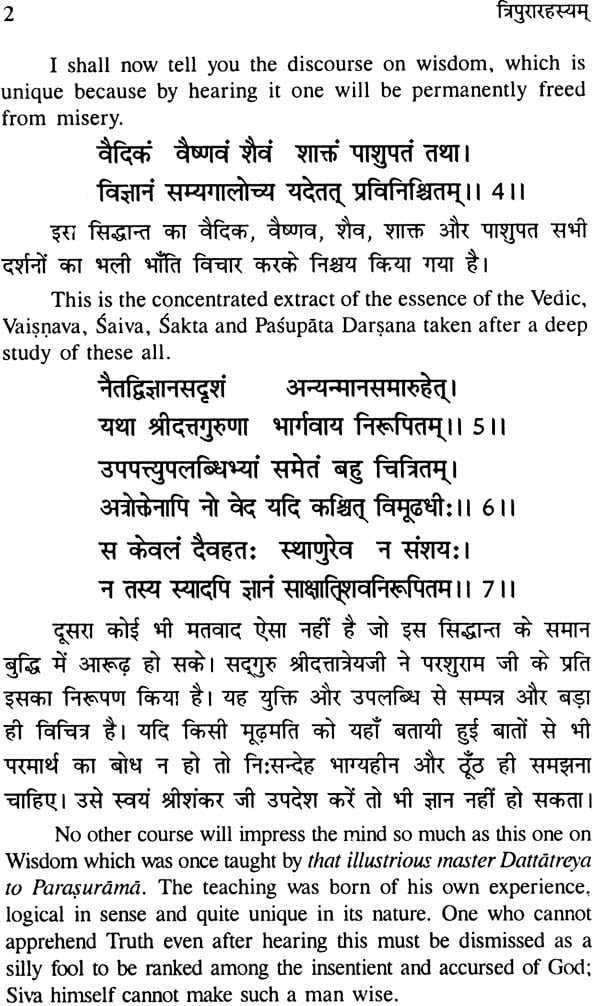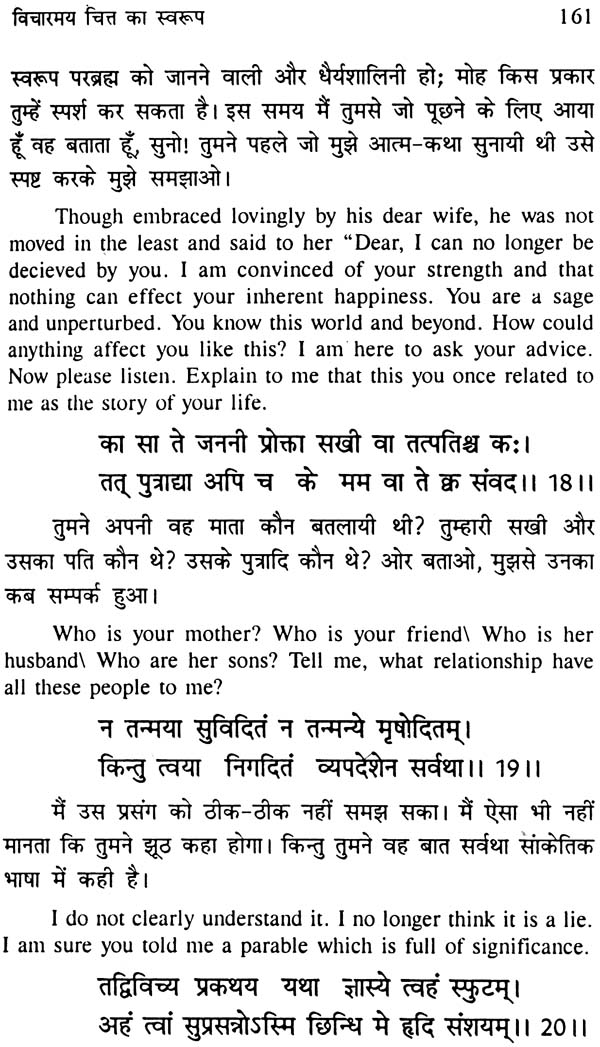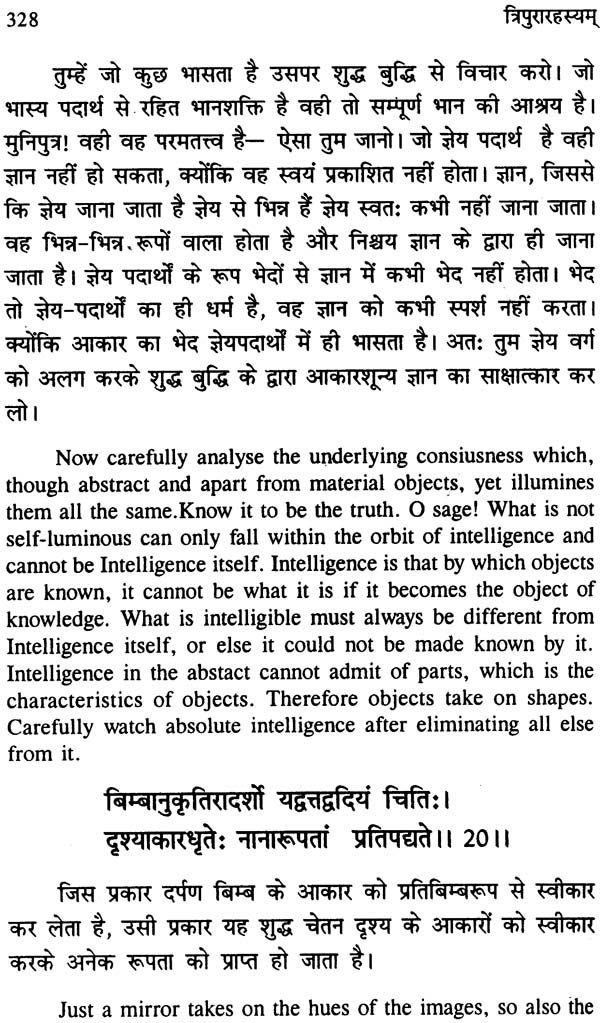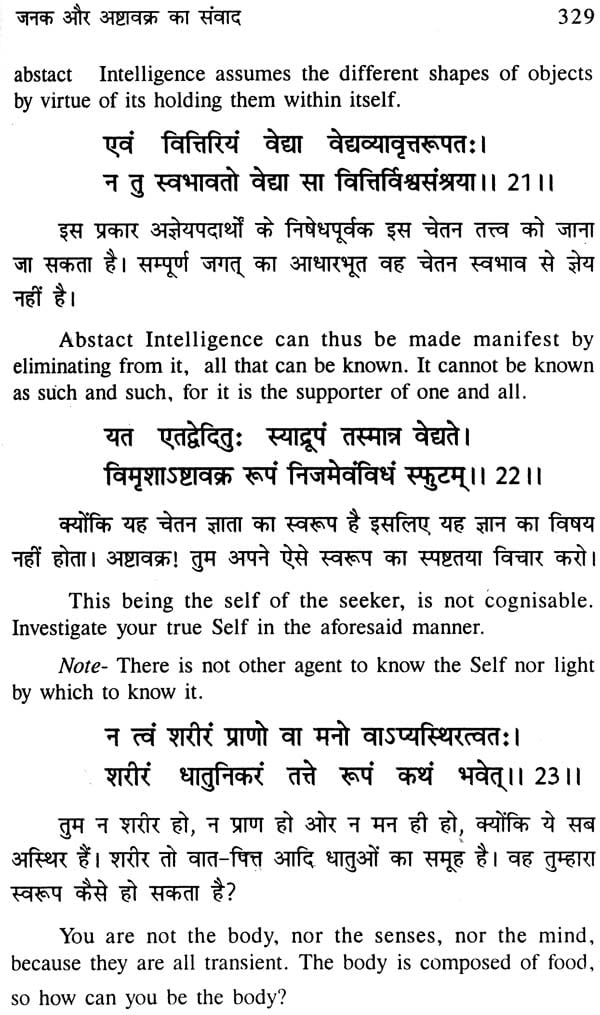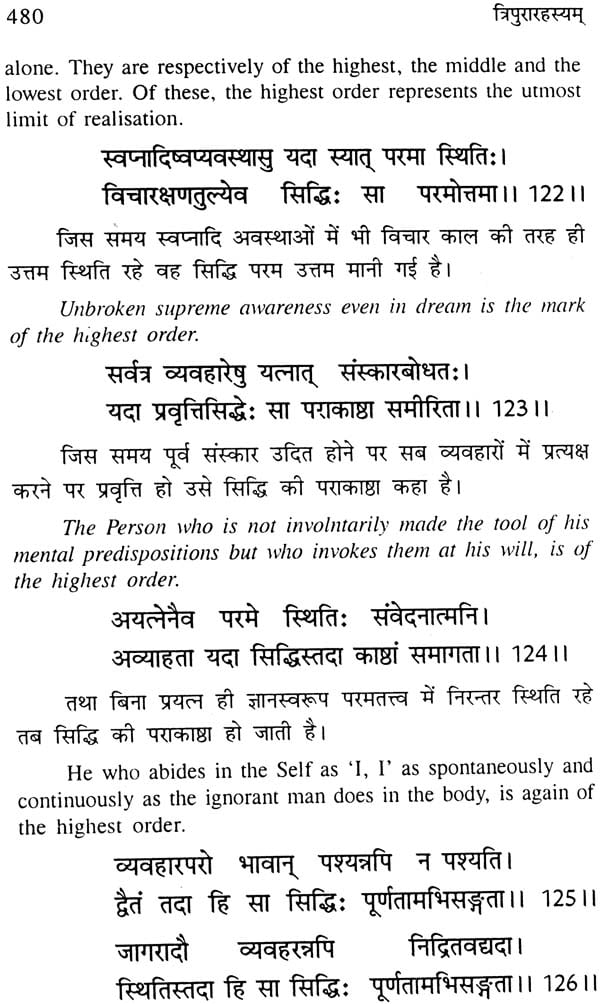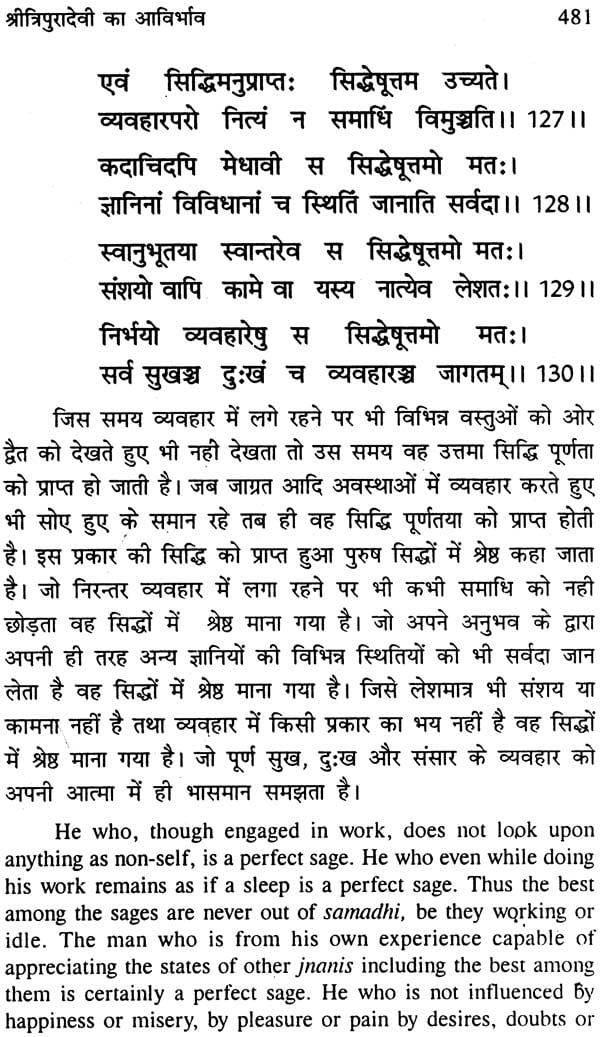
Shri Tripura Rahasyam (Jnana Khanda) - Discourses on Wisdom
Book Specification
| Item Code: | NAP391 |
| Author: | Prof. Pushpendra Kumar |
| Publisher: | Eastern Book Linkers |
| Language: | Sanskrit Text with Hindi and English Translations |
| Edition: | 2003 |
| ISBN: | 9798178540190 |
| Pages: | 606 |
| Cover: | Hardcover |
| Other Details | 8.5 inch X 5.5 inch |
| Weight | 880 gm |
Book Description
The present book Shri Tripura-rahasyam is a celebrated Tantric Text widely respected all over the country. Specially its Thana-khancla deals in detail the concept of Chiti i.e. the human consciousness. According to this book 'Chiti' or `Para-chiti' is none other than the goddess Tripura, considered to be the highest reality. The whole of the Shri Tripura-rahasyam is full of dis-courses on the concept of chiti by the renowned sage Dattatreya. It consists of 22 chapters dealing with the nature of world, nature of God, and the Samadhi etc. The goodess says that the whole creation is imagination and it is supported by the creation of shilaloka, i.e. creation of Hill state. The book is worth-reading and the readers will enjoy its reading. This is the only Tantra where only discussion and discourses are there and no details of Tantric Pooja Paddhati. The goddess Tripura is Vaishnava goddess and is worshipped according to Samayachara. The Hindi and English translation will help the readers for its understanding.
Prof. Pushpendra Kumar has retired from the University of Delhi—Sanskrit Deptt. after serving it for more than forty years. He served this Deptt. as lecturer, Reader and Professor and Head of the Deptt. More than 20 books are highlighting his acadmic merit. He has written more than seventy research articles. He has travelled widely in the European Universities for higher studies and lectures. Besides many honours and awards, He has been honoured by the 'Certificate of Honour' by the President of India in the year. 2000 for his meritorious service for Sanskrit and for his schoolarship. He specilizes in the Pur4as, Tantras, Buddhism, Indian Art, Epigraphy, Sanskrit Literature and Aesthetics. He is presently working on a major project 'Cultural Heritage from the Puranas'.
Tripura Rahasya (Gyanakhanda) is a very popular and celebrated tantra. It deals with the philosophical ideas of tantras. As the name Gyanakhanda- indicates it is nothing but the discourses on internal knowledge may be called Para Vidya. Our Rishis used to say 'सा विद्या या विमुक्ताये' The knowledge makes a man devoted and emancipated. It is one of the most important Agama of Shaktas. It is not known when it was written and by whom. But the text itself says that its author was sage Haritayana. It is a dialogue between Parashurama and Dattatrerya. We know that Parshurama was born in Bhargava clan, and was a great sadhaka and disciple of Shiva. We have heard that he was a great propagator of Tantra. He listened the great glory of the goddess Tripura from the mouth of sage Dattatreya. He is also considered the incarnation of all the three deities viz. Brahma, Vishnu and Mahesa.
This whole discourse was given to sage Narada by Haritayana. Parashuram went to Mahendra Hill and made a penance for the goddess Tripura. During that period many doubts and questions arose in the mind of Rama and he went again to Dattatrey who made him fully counvinced and clear in his mind. This whole episode makes it clear that unless the person is not pious internally, he will not be able to grasp this Paramatattva. The text says that Parasurama went to sage Samvarta for his doubts and queries. Samarta younger brother o वृहस्पति, was very high scholar on this topic but the doubts of Parashurama were not removed, by his preachings.
Who was Haritayana, we have no details about him. Similarly we don't know anything about Samvarta. But these personalities were great exponents of Tantrik-vidya and gaktism. This book though a tantra but there are no detail about Tantra-Worship only the discussions on पराचिति, the goddess Herself.
The book comprises of more than 2000 verses and is divided in 22 chapters. It is devoted to the glory of the great goddess Tripura—who is consciousness (चिति) itself. She is Adya, अंत स्वरूपा, भासमाना, सविन्त Lord of the Universe, creator and the evolutor of the world. The important thing is that besides the main narrator Dattatreya and Parasurama the discourses on knowledge are given by the ladies in this book. First Speaker is the queen Hemaprabha of king Hemachuda. The queen gives a lecture to her husband about the nature of world and nature of god. From beginning to end she goes Counseling her husband till he understands the height of reality of 1. पारचिति. The 2nd speaker is a Samyasini who questions the sage Asthaka and defeats him. Astaka humbly speaks out his limitation of bookish knowledge and no personal experiences. She removes the doubt and goes out of the court directing king Janak to clear the doubts.
Lastly the goddess speaks herself about the nature of the world outside. The world inside, the consciousness and the nature of Atma and the nature of emancipation. The first part of the book deals with a narrative of Devi (Sakti-Sri Tripura), Her worship and Her grace. Tripura literally means the three cities. There are three states—Jagrat, Svapna and Sushupti. The undercurrent of consciousness is in all of them, remaining unaffected is metaphorically called the Resident Mistress by name Sri Tripura. The procreative faculty generating new beings and the link of altruistic love connecting the offspring to the parent are personified in the Mother. Hence the feminine term of Tripura. "The way to transcendence" signifies that interest in Tripura purifies the mind and creates the zeal for enquiry into Truth. The listener is now fit for the ensuring discourse on wisdom.
We shall now have discourse on wisdom, which is unique because one will be permanently freed from misery, by hearing it. This is the concentrated extract of the essence of the Vedic, Vaishnava, gaiva, gakta and Pagupata lore taken after deep study of them all.
Five Tattvas According to Tripura Rahasya Shiva is awareness of the 'exterior', and Sakti is the dynamic force operating the potential tendencies in the individual self. When the awareness of the `exterior' combined with the 'I' encompasses the entire imagined space as 'I' and it is called Sada-Siva-Tattva. That consciousness which illumines the 'exterior' ‘is called Siva tattva, whereas the individual feeling as 'I' is Sakti-tattva.
When, discarding the abstraction of the self and the exterior, clear identification with the insentient space takes place, it is called ईश्वरतत्त्व. The investigation of the last two steps is pure vidya. All these five Tattvas are pure because they relate to an yet-undifferentiated conditions like potentialities in a seed.That insentient predominance is called मायाशक्ति often differentiation is clearly established, like the sprout from a seed. According to Tripura-Rahasya, Paramatattva, is pure consciousness, pervaded everywhere and free from all limitations. It is a store house of unlimited energies and fully integrated in that and fully independent. Its powers are integrated with it and not different from chiti. Before creation all these powers are hidden in the unmanifested Brahman. While at the time of creation the consciousness by her own will power संकल्प शक्ति mainfests the world in herself like an image in the mirror, though the space, action and time are also seen in chiti, but chiti remains unattached with these things as mirror remains unaffected with the objects seen into it.
